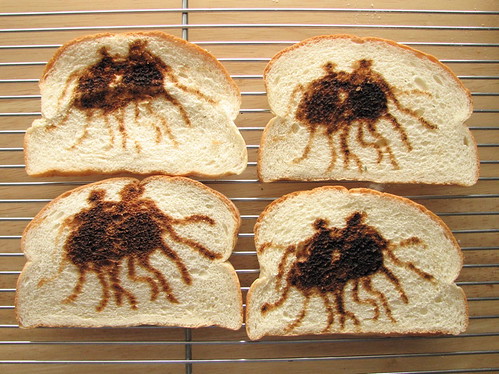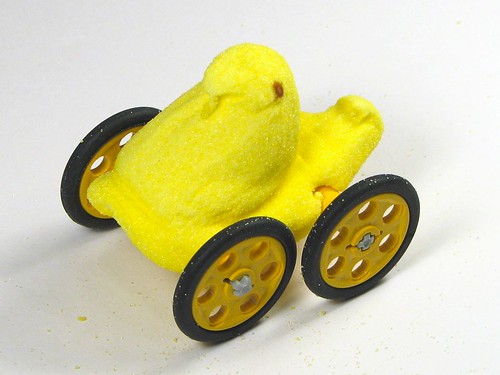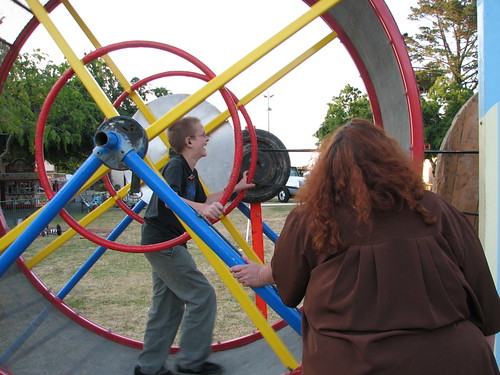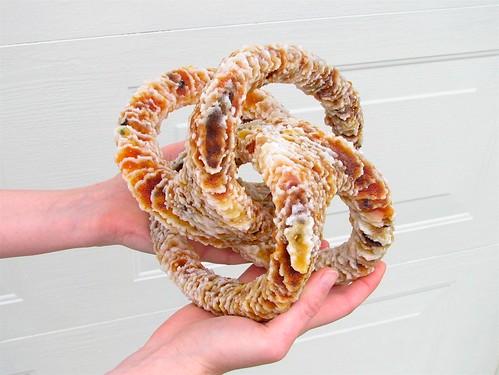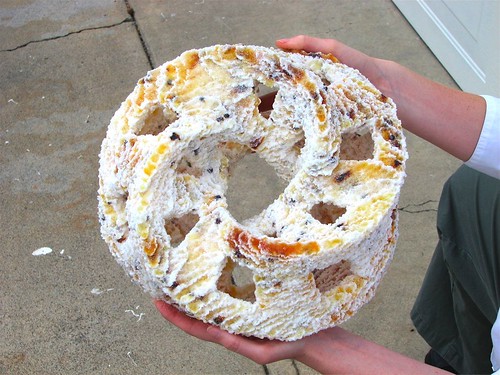This article contains some reference data– pinouts and the font table– relevant to the LED Micro-readerboard, version 2.0.
Continue reading LED Micro-Readerboard, version 2.0: Technical Data
The Flying Spaghetti Monster, on toast
One of the things that we kept hearing as a comment about our CNC toast story is that we really should be printing the Virgin Mary on grilled cheese sandwiches, or something like that.
As it turned out, by the time that we actually wrote about our toasting, we had already moved on to bigger and (probably) better things, like printing sugar. Since we were rushing to get ready for Maker Faire, we didn’t get a chance to make more creative toast.
But, Maker Faire has come and gone, and we’ve finally got our machine reassembled, and so here we are toasting again. Believe it or not, this is actually a step in the right direction for CandyFab as well, because these were printed at 20 DPI, already an improvement with four times as many pixels as our previous batches at 10 DPI. These four Flying Spaghetti Monster images on toast are adapted from the original artwork in pencil, by Bobby Henderson.
Oh yeah, and I put one of them on eBay. =D
Learn about microcontrollers at TechShop

Coming up real soon now: Three microcontroller-oriented classes, on Saturday afternoons at TechShop, at different levels of skill and with different emphases:
- Sat. June 9, 1:00 PM: Make a Micro Readerboard
- Sat. June 16, 1:00 PM: Introduction to AVR Microcontrollers
- Sat. July 7, 1:00 PM: Choosing a Microcontroller
The classes are held at TechShop, a San Francisco Bay Area “open-access public workshop,” located just off of 101 in Menlo Park, where you can go use a wide range of tools to make things, and take all kinds of classes.


Make a custom LED Micro-Readerboard
Next Saturday, June 9, I’ll be giving a fun little class, suitable for anyone with a bit of soldering experience (even youngsters), where you can customize the phrases in and assemble an LED Micro-Readerboard. It’s a cute little thing that spells out a preprogrammed messages (e.g., your name), one letter at a time, on a single-character alphanumeric display. These are much like the ones that we programmed to be holiday ornaments a few months ago, but these are actually extra-spiffy version 2.0 micro-readerboards with higher brightness and better battery life. And, if you take the class, you get to choose what messages to put on your readerboard and take it home. It’s a neat, self-contained project that’s a great example of what you can do with a little AVR microcontroller.
(UPDATE: Second class added on June 30, also at 1:00 PM.)
And speaking of AVR Microcontrollers….
Introduction to AVR Microcontrollers
Saturday, June 16, 1:00 PM
You may have noticed that a number of our interesting projects are based around AVR microcontrollers. AVR microcontrollers are powerful and inexpensive single-chip computers that are available in a wide range of sizes. They also happen to be remarkably easy to program in C, using entirely free and open-source tools that run on Macs, Windows, and Unix-like operating systems. In this practical introduction to AVR microcontrollers, we’ll take it from the beginning so that you can go home and use AVRs for your own cool projects. Some topics to be covered include: different types of AVRs and how to pick one, what kinds of programmer you should get, how to install the software tools, how to get started actually programming them, and how to download and run your code on the microcontroller.
Finally, on July 7, I’ll be giving a repeat of this introductory microcontroller class, called Choosing a Microcontroller. This large-format seminar is designed to be a broad introduction to the capabilities and variety of single-chip computers, as well how to actually pick one for a given application. It’s easy to get overwhelmed looking at the variety of range of micros, from four-bit micros that have a 4-bit wide data path — and actually cost four bits— to AVRs and PICs, basic stamps and Arduinos, to 32-bit gorillas with names like ARM, Blackfin, and Coldfire. So, we’ll try and cut through the fog and help you figure out where to get started.
If you’ve heard people getting excited about or doing cool things with microcontrollers and want to learn more, this might be a great introduction to the field.
Sign up for these and other TechShop classes here.
(By the way, it’s hard to tell what types of things people want to learn about. So, if you have suggestions for other classes that you’d like to see taught by the Evil Mad Scientists, you can E-mail us or leave comments here or in the forums.)
Make a Wire Storage Tower
If you accumulate project material like we do, you’ve probably got a heap of half-empty wire spools from junk shops taking up space in a box or on a desk. We’ve got a simple solution for you: a small flat piece of metal or wood, some tape, some felt feet, and a rod. Read on for details.
Continue reading Make a Wire Storage Tower
Maker Faire Bay Area 2007 was fantastic!
 Maker Faire was a smashing success. The big message of the fair was summarized succinctly and stamped on the back of a card we were given: “Kill Your Television and Make Stuff!”
Maker Faire was a smashing success. The big message of the fair was summarized succinctly and stamped on the back of a card we were given: “Kill Your Television and Make Stuff!”
We had a great time in our little prototyping world off in the corner of the Expo hall by SRL. Near us Bathsheba Grossman had her beautiful sculptures, Fab@Home was printing with cheese and frosting, John Guy had his 3D CNC gantry next to his margarita machine, and Lee Krasnow had an entire workshop for his precision puzzle making. We were also by a couple of exhibitors (as opposed to makers): Epilog and Protopulsion, but I have to say, it seemed like the makers all got a lot more traffic than the corporate folks with their tradeshow-style setups. We were all off behind the Tesla coils, which stole our visitors’ attention hourly. Nobody could compete with the Tesla coils when they were running!
We can’t possibly list all of the cool things we saw, and we didn’t see half of the stuff there, but read on for some of the highlights for us.
Continue reading Maker Faire Bay Area 2007 was fantastic!
Evilmadscientist Linkdump: May 2007
Today we have a fine crop of choice links, hand picked at the point of perfection, for your viewing pleasure:
- First, a neat article from The Times Online about 3D printing, that gives a nice mention to the CandyFab 4000
- A Video Compilation of the short list of video finalists for the Phylm prize (of which we are among the judges).
- Suggested by Brian Gaut: the cartalator. That’s the shopping cart escalator found at Target and a few other big box stores. (I’ve seen them for years, but I’ll admit to thinking it was really cool when I first saw one.)
- Bookend snippets from the Japanese children’s program, Pythagoras Switch (suggested by an anonymous reader). These are Rube Goldberg machines based on rolling balls and you simply mustwatch these videos if you have not seen them– plan fifteen minutes where you don’t need to pay attention to anything else. The folks that make these videos have the coolest job in the world.
- Translations in many languages of that most useful of phrases, “My hovercraft is full of eels.”
- Seriously disturbing Lego, but made with remarkable talent. (Additional pictures in gallery.)
- There is actually a formula to compute actual size of a #6 (for example) screw!
We are also inducting several new Honorary Mad Scientists into the fold today:
- Graham Stabler who makes all kinds of amazing things including tiny flying machines and homebrew CNC machines.
- John Maushammer, who has among other projects, developed the Pong Watch
- Bruce Shapiro, whose motion control art installations are truly remarkable
- Christy Canida, who has made remarkable strides in instructing the world in good cooking and strange taxidermy– a combination that certainly qualifies for mad scientist status!
- Raven Hanna, a molecular biophysicist turned artist– our brand of Mad Science exactly. She now runs Made with Molecules (Go get your molecules on.)
Make a peepmobile
Here’s how to take your left over Marshmallow Peeps, add a few components, and make them into pimped-out peepmobiles.
Okay, so Easter has come and gone. Really gone. And if you’re like us, you didn’t eat all of your Peeps. Have they gone bad by now? Probably not. As it turns out, the yellow chick-shaped Peeps are made all year long to build up enough supply for each easter, so the ones that you get for Easter could *already* be a year old. (So why can’t you buy them all year long? You can… you just have to know where to look.)
Even if you’re still saving your Chicks to eat them later, you’re not alone. The official Peeps site has a poll up asking whether you like your Peeps “Fresh from the package or aged to perfection.” According to the results so far, a full 12% of peepeaters like to wait six months or more.
However, we seem to be digressing. Let’s just go ahead and assume that you weren’t going to eat all of them. Then whatever’s left, you can make into Peepmobiles.
Continue reading Make a peepmobile
Interactive LED coffee tables
Last year at Maker Faire, we showed off our interactive LED dining table. There, we met the fine folks at Because We Can, who make amazing mostly wooden things with a little help from their robot. We eventually all decided on collaborating to design and build a new series of interactive coffee tables. We’ve just wrapped up the project and are introducing them this weekend at Maker Faire.
Besides what is written about them on this page, you can read more about them on the
Because We Can Blog, and you can also see lots of photos in the product pages for the two different coffee table designs: the wave and the ripple.
The new tables are designed to look really great whether or not you can see the LEDs. The wooden bases are elegant and attractive, and also if you go up to one and touch it, it will respond by pleasantly lighting up in that area. The tables are designed to respond in a subtle and gentle fashion to stimulus provided by human interaction. They are normally dim and constant– the most you’ll see in a dark room is a faint glow of twinkling like the night sky. When you set your glass down on the table, however, the table “sees” the motion that induces a slow ripple starting in that location that spreads out to other areas of the table as it dissipates. The overall effect is a bit like touching a pool of water, in that your local disturbance turns into an overall gentle rippling, and eventually settles down. It is decidedly not a disco floor– there is no blinking, no programmed oscillations, or for that matter, any digital electronics at all– the circuitry is completely analog to improve aesthetics and reduce eyestrain.
Maker Faire 2007 – now with pictures!
Maker Faire is shaping up to be a fantastic event! I’ve taken a few pictures, and I’ll add more to the set as I manage to get them uploaded. Pictured above is a very giggly evil mad scientist operating The Disgusting Spectacle.
Please also check out Scott Beale’s coverage so far. He shot a beautiful portrait of one of our dodecahedrons.
We’re having a blast, and we hope to see you there!
A few more sugar sculptures
This is a rendering of the sculpture Soliton by Bathsheba Grossman, as output by the CandyFab 4000; it’s a three-dimensional form made out of pure sugar. Seeing Bathsheba’s sculptures at the 2006 Maker Faire was the inspiration for us to build the machine in the first place, so it’s quite exciting to be able to print this. (The design is used by her kind permission– please buy some of her sculptures!)
This is our second try at fabbing this difficult shape. Our first attempt was at a somewhat smaller size and ran into trouble with the thin beams when *one* of our thin horizontal layers turned out to be too weakly bonded. To avoid a second failure, we enlarged the model but also ran the heater element very hot and for an extended period of time to make the pixels srong, but also larger, more rounded, and richer in color– a darker caramel.
In this view we’re looking right down at the printed layers of sugar; we think that the grain of the layers makes this look a lot like a wood carving.
Of course, that’s not all that we’ve been printing this week. Here is one more large-scale object that we made:
The shape is a 3/4 twist mobius strip with a square cross section and windows cut at regular intervals in all of the sides the side. Even though it’s hollow, it still weighs seven pounds and fourteen ounces– that’s a lot of sugar. We’re bringing this monster to Maker Faire this weekend, so you can see it for yourself, too.




